
Platystemon is a monotypic genus of flowering plants in the poppy family containing the single species Platystemon californicus, which is known by the common name creamcups. It is native to Oregon, California, Arizona, Utah and Baja California, and is found in open grasslands and sandy soils below 6,000 feet (1,800 m) elevation.
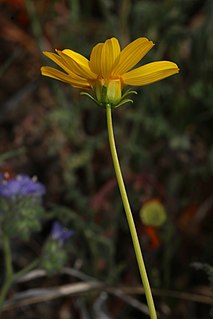
Coreopsis bigelovii is a species of flowering plant in the daisy or sunflower family, Asteraceae, with the common names Bigelow coreopsis and Bigelow's tickseed. It is endemic to California.

Trixis californica , the American threefold or American trixis, is a species of flowering plant in the family Asteraceae. It is native to the southwestern United States in California, Arizona, New Mexico, and Texas, and in Mexico in the states of Baja California, Chihuahua, Coahuila, Durango, Nuevo León, Sinaloa, Sonora, Tamaulipas, and Zacatecas.
Hulsea californica is a rare species of flowering plant in the family Asteraceae known by the common names San Diego alpinegold and San Diego sunflower. It is endemic to southern California, where it grows only in the Peninsular Ranges.

Lasthenia californica is a species of flowering plant in the family Asteraceae known by the common name California goldfields. It is native to California, Oregon and surrounding areas, where it is a very common member of the flora in a number of habitat types.
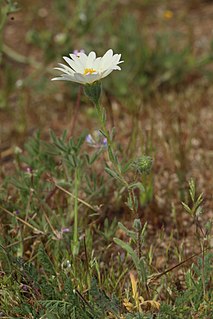
Layia glandulosa is a species of flowering plant in the family Asteraceae known by the common names whitedaisy tidytips and white layia. It is native to western North America south from central Washington (state) to Baja California and east to Utah and Arizona, where it is common in a number of habitat types.
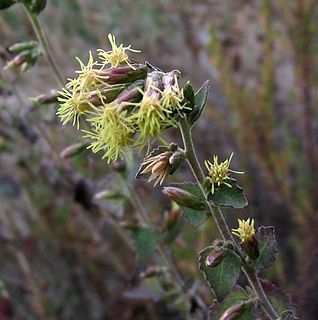
Brickellia californica, known by the common name California brickellbush, is a species of flowering plant in the family Asteraceae.

Chaenactis glabriuscula, with the common name yellow pincushion, is a species of flowering plant in the daisy family. It is native to California and Baja California.

Coreopsis douglasii is a species of flowering plant in the family Asteraceae known by the common name Douglas' tickseed. It is native to California from Santa Clara County to San Diego County, as well as from Mohave County in Arizona.
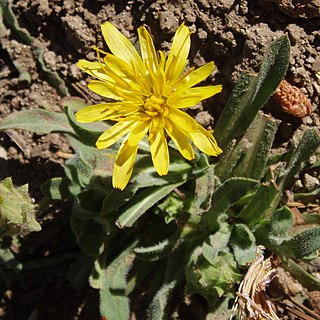
Agoseris retrorsa is a North American species of flowering plant in the family Asteraceae known by the common name spearleaf agoseris or spearleaf mountain dandelion.

Malacothrix floccifera is a species of flowering plant in the family Asteraceae known by the common name woolly desertdandelion. It is native to many of the northern and central mountain ranges of California, including the Sierra Nevada, where its distribution extends into Nevada. Its habitat includes forest, woodland, and chaparral. It is an annual herb producing a hairless flowering stem up to about 42 centimeters in maximum height. The fleshy oblong leaves are cut into teeth or lobes and have cottony patches of woolly fibers. The inflorescence is an array of flower heads lined with hairless phyllaries. The ray florets are up to 1.5 centimeters long and are often white, but sometimes yellow.

Blepharizonia is a genus of flowering plants in the family Asteraceae. There are two species, both endemic to California. They are known generally as big tarweeds.

Pyrrocoma apargioides is a species of flowering plant in the family Asteraceae known by the common name alpineflames. It is native to the western United States from the Sierra Nevada of California east to Utah, where it grows in the forests and meadows of high mountains. It is a perennial herb growing from a taproot and producing one or more stems to 30 centimeters in length. The stems are decumbent or upright, reddish, and hairless to slightly woolly. Most of the leaves are located around the base. They are thick and leathery, lance-shaped with large sawteeth along the edges, often center-striped in white, and measure up to 10 centimeters long. The inflorescence is usually a single flower head lined with centimeter-long phyllaries which are reddish to green with red edges. The head has a center of yellow disc florets and a fringe of ray florets which are yellow, often splashed with red along the undersides, measuring up to 1.6 centimeters in length. The fruit is an achene which may be well over a centimeter in length including its pappus.
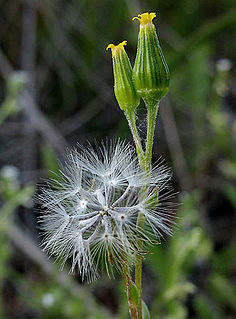
Senecio aphanactis, known by the common names chaparral ragwort, rayless ragwort, and California groundsel, is a species of flowering plant in the aster family.
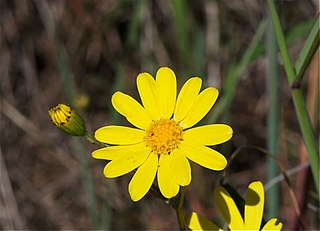
Senecio californicus is a species of flowering plant in the aster family known by the common name California ragwort.
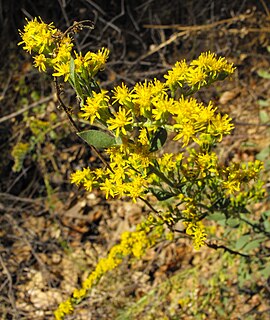
Solidago californica is a species of goldenrod known by the common name California goldenrod.
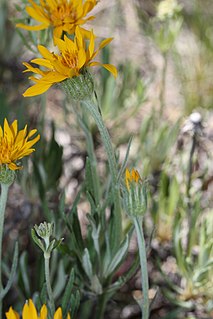
Stenotus lanuginosus is a species of flowering plant in the family Asteraceae known by the common names woolly mock goldenweed and woolly stenotus.
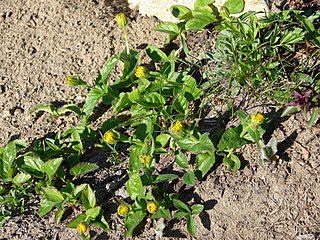
Tonestus lyallii is a species of flowering plant in the family Asteraceae known by the common names Lyall's goldenweed, Lyall's serpentweed and Lyall's tonestus. It is native to western North America, particularly in the Rocky Mountains and the mountain ranges of the Pacific Northwest with scattered occurrences between. It is a perennial herb growing in clumps or short bunches not more than about 15 centimeters tall, the stem branching from a tough caudex. The leaves are smooth-edged and linear or lance-shaped, the largest at the base of the plant reaching up to about 8 centimeters long. The inflorescence is a single flower head or a pair of heads each about a centimeter wide with green or red phyllaries. The head bears at least 10 or 11 bright yellow ray florets around a center containing many tubular disc florets.
Malacothrix junakii is a rare species of flowering plant in the family Asteraceae known by the common names Anacapa Island desert-dandelion, Junak's desertdandelion, and Junak's malacothrix. It is endemic to Anacapa Island, one of the Channel Islands of California, where it is known from just two occurrences. It occurs in the coastal scrub of the island. It was described to science as a new species in 1997.

Symphyotrichum racemosum is a species of flowering plant native to parts of the United States and introduced in Canada. It is known as smooth white oldfield aster and small white aster. It is a perennial, herbaceous plant in the family Asteraceae. It is a late-summer and fall blooming flower.



















